
Woodworking is the skill of making items from wood, and includes cabinetry, furniture making, wood carving, joinery, carpentry, and woodturning.

A handicraft is a traditional main sector of craft making and applies to a wide range of creative and design activities that are related to making things with one's hands and skill, including work with textiles, moldable and rigid materials, paper, plant fibers, clay, etc. One of the oldest handicraft is Dhokra; this is a sort of metal casting that has been used in India for over 5,000 years and is still used. In Iranian Baluchistan, women still make red ware hand-made pottery with dotted ornaments, much similar to the 4,000-year-old pottery tradition of Kalpurgan, an archaeological site near the village. Usually, the term is applied to traditional techniques of creating items that are both practical and aesthetic. Handicraft industries are those that produce things with hands to meet the needs of the people in their locality without using machines.
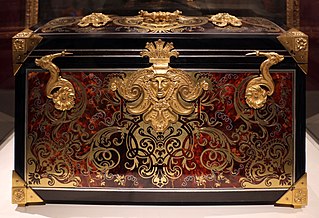
Marquetry is the art and craft of applying pieces of veneer to a structure to form decorative patterns or designs. The technique may be applied to case furniture or even seat furniture, to decorative small objects with smooth, veneerable surfaces or to freestanding pictorial panels appreciated in their own right.

Wood carving is a form of woodworking by means of a cutting tool (knife) in one hand or a chisel by two hands or with one hand on a chisel and one hand on a mallet, resulting in a wooden figure or figurine, or in the sculptural ornamentation of a wooden object. The phrase may also refer to the finished product, from individual sculptures to hand-worked mouldings composing part of a tracery.
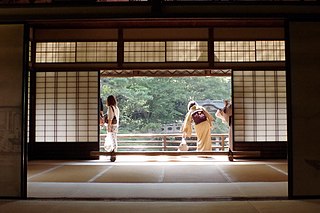
A shoji is a door, window or room divider used in traditional Japanese architecture, consisting of translucent sheets on a lattice frame. Where light transmission is not needed, the similar but opaque fusuma is used. Shoji usually slide, but may occasionally be hung or hinged, especially in more rustic styles.
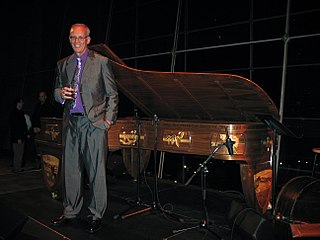
Silas Kopf is an American furniture maker specializing in the art of marquetry. Kopf graduated from Princeton University in 1972 with a degree in architecture and soon began designing and making furniture. In 1988, he received a Craftsman's Fellowship from the National Endowment for the Arts, and used the opportunity to study traditional marquetry technique at the École Boulle, an institute of interior architecture and design, in Paris. His major projects include several pianos commissioned by Steinway & Sons and benches, desks, and cabinets for private collections and museums. His designs frequently incorporate floral depictions, other images from nature, and trompe-l'œil concepts. He first became interested in marquetry because he hoped for an alternative, less consumerist lifestyle.

Tunbridge ware is a form of decoratively inlaid woodwork, typically in the form of boxes, that is characteristic of Tonbridge and the spa town of Royal Tunbridge Wells in Kent in the 18th and 19th centuries. The decoration typically consists of a mosaic of many very small pieces of different coloured woods that form a pictorial vignette. Shaped rods and slivers of wood were first carefully glued together, then cut into many thin slices of identical pictorial veneer with a fine saw. Elaborately striped and feathered bandings for framing were pre-formed in a similar fashion.
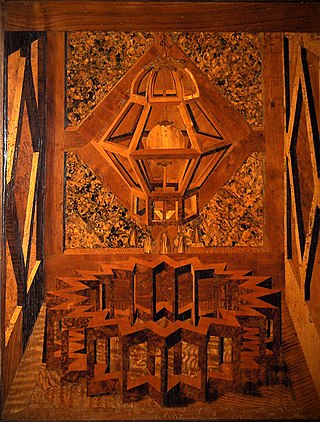
Intarsia is a form of Arab wood inlaying that is similar to marquetry. The start of the practice dates from before the seventh century AD. The technique of intarsia inlays sections of wood within the solid wood matrix of floors and walls or of tabletops and other furniture; by contrast marquetry assembles a pattern out of veneers glued upon the carcass. The word intarsia may derive from the Latin word interserere.

A lath or slat is a thin, narrow strip of straight-grained wood used under roof shingles or tiles, on lath and plaster walls and ceilings to hold plaster, and in lattice and trellis work.

In woodworking, veneer refers to thin slices of wood and sometimes bark that typically are glued onto core panels to produce flat panels such as doors, tops and panels for cabinets, parquet floors and parts of furniture. They are also used in marquetry. Plywood consists of three or more layers of veneer. Normally, each is glued with its grain at right angles to adjacent layers for strength. Veneer beading is a thin layer of decorative edging placed around objects, such as jewelry boxes. Veneer is also used to replace decorative papers in wood veneer high pressure laminate.

A floor medallion is generally a centerpiece of flooring design that can be made with various flooring materials, including natural stone, wood, metal, tile, glass or a variety of other materials suitable for flooring. The pattern can be created using various methods such as mosaic, intarsia, and marquetry.
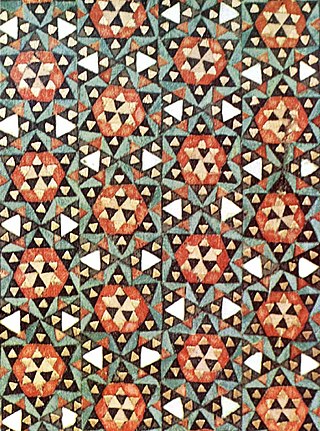
Khātam is an ancient Persian technique of inlaying. It is a version of marquetry where art forms are made by decorating the surface of wooden articles with delicate pieces of wood, bone and metal precisely-cut intricate geometric patterns. Khatam-kari (خاتمکاری) or khatam-bandi (خاتمبندی) refers to the art of crafting a khatam. Common materials used in the construction of inlaid articles are gold, silver, brass, aluminum and twisted wire.

Opus sectile is a form of pietra dura popularized in the ancient and medieval Roman world where materials were cut and inlaid into walls and floors to make a picture or pattern. Common materials were marble, mother of pearl, and glass. The materials were cut in thin pieces, polished, then trimmed further according to a chosen pattern. Unlike tessellated mosaic techniques, where the placement of very small uniformly sized pieces forms a picture, opus sectile pieces are much larger and can be shaped to define large parts of the design.
The following outline is provided as an overview of and topical guide to crafts:
This glossary of woodworking lists a number of specialized terms and concepts used in woodworking, carpentry, and related disciplines.

Inlay covers a range of techniques in sculpture and the decorative arts for inserting pieces of contrasting, often colored materials into depressions in a base object to form ornament or pictures that normally are flush with the matrix. A great range of materials have been used both for the base or matrix and for the inlays inserted into it. Inlay is commonly used in the production of decorative furniture, where pieces of colored wood, precious metals or even diamonds are inserted into the surface of the carcass using various matrices including clear coats and varnishes. Lutherie inlays are frequently used as decoration and marking on musical instruments, particularly the smaller strings.

Certosina is a decorative art technique of inlaying used widely in the Italian Renaissance period. Similar to marquetry, it uses small pieces of wood, bone, ivory, metal, or mother-of-pearl to create inlaid geometric patterns on a wood base. The term comes from Carthusian monasteries, probably the Certosa di Pavia, where the technique was used in ornamenting an altarpiece by the Embriachi workshop.

Edge banding or edgebanding is the name of both a process, and an associated narrow strip of material. It is used to create durable and aesthetically pleasing trim edges during finish carpentry. The method is used to cover the exposed sides of materials such as plywood, particle board, or MDF. This increases durability and creates the appearance of a more solid or valuable material.

William Tunberg is an American artist specializing in marquetry, sculpture, drawing and assemblage (art). He lives and works in Venice, California.

The Metropolitan Museum of Art has on display a complete studio from the Palazzo ducale di Gubbio. Consisting of period woodwork from late 15th century Italy, the studio was commissioned for Federico da Montefeltro.

















